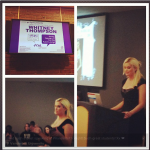A Model Example

It seems appropriate, with New York Fashion Week wrapping up just last week, for Vanderbilt to host Whitney Thompson as a speaker. She is the first, and only, plus-size winner of America’s Next Top Model. It seemed a little odd to be hosting this superstar in the Pi and Leaf Lounge in our Rand Dining Center, but the casual atmosphere of our college dining room makes everything she says more personal and down-to-earth.
If I were to picture a plus-size model, Whitney wouldn’t be close to an example of what I would imagine. Plus size models are classified as any model above size 6, despite the fact that an average american woman is size 14. Before college and America’s Next Top Model, 15 year old Whitney was a normal sized model. “When puberty hit, I started changing. Naturally, my hips got bigger. People told me if I lost an inch off of my hips I would be perfect and make it big.” Under the supervision of a strict trainer, she attempted to lose the weight, dieting and exercising aggressively. Despite all her attempts, she could not lose that inch. Whitney’s situation is not unheard of. A majority of models are under the age of 16 and, as they get older, they grow out of size 0. At the risk of losing contracts, many will take up extreme regimens. Bar Rafaeli, a fellow model’s tweet in 2010 encapsulates the situation, “I get so sad when I see 15-year-old pale extremely skinny models at the agency looking all shaky and hungry…. when will it end?!?!?”
Still, progress has been made. Recent laws now prohibit models from being under 16 years old. However, there is more change to be made in America. Israel has recently made it illegal for models to be below an 18.5 BMI and Great Britain has mandated strict laws against excessive photoshopping and airbrushing. An ambassador for the National Eating Disorders Association, Whitney describes her mission, “I am not modeling to better my career–its about changing the industry. I won’t stop until its changed!”
The fashion industry has changed the way women view themselves. “I used to hate my thighs. My mom would call them cheerleader thighs” says Whitney. “I would squat, work them out, run and finally I realized: my mom has cheerleader thighs, my grandmother has cheerleader thighs. Every part of us is something that was given to us: a legacy handed down through generations. Its beautiful when you come to realize that you truly are unique.”